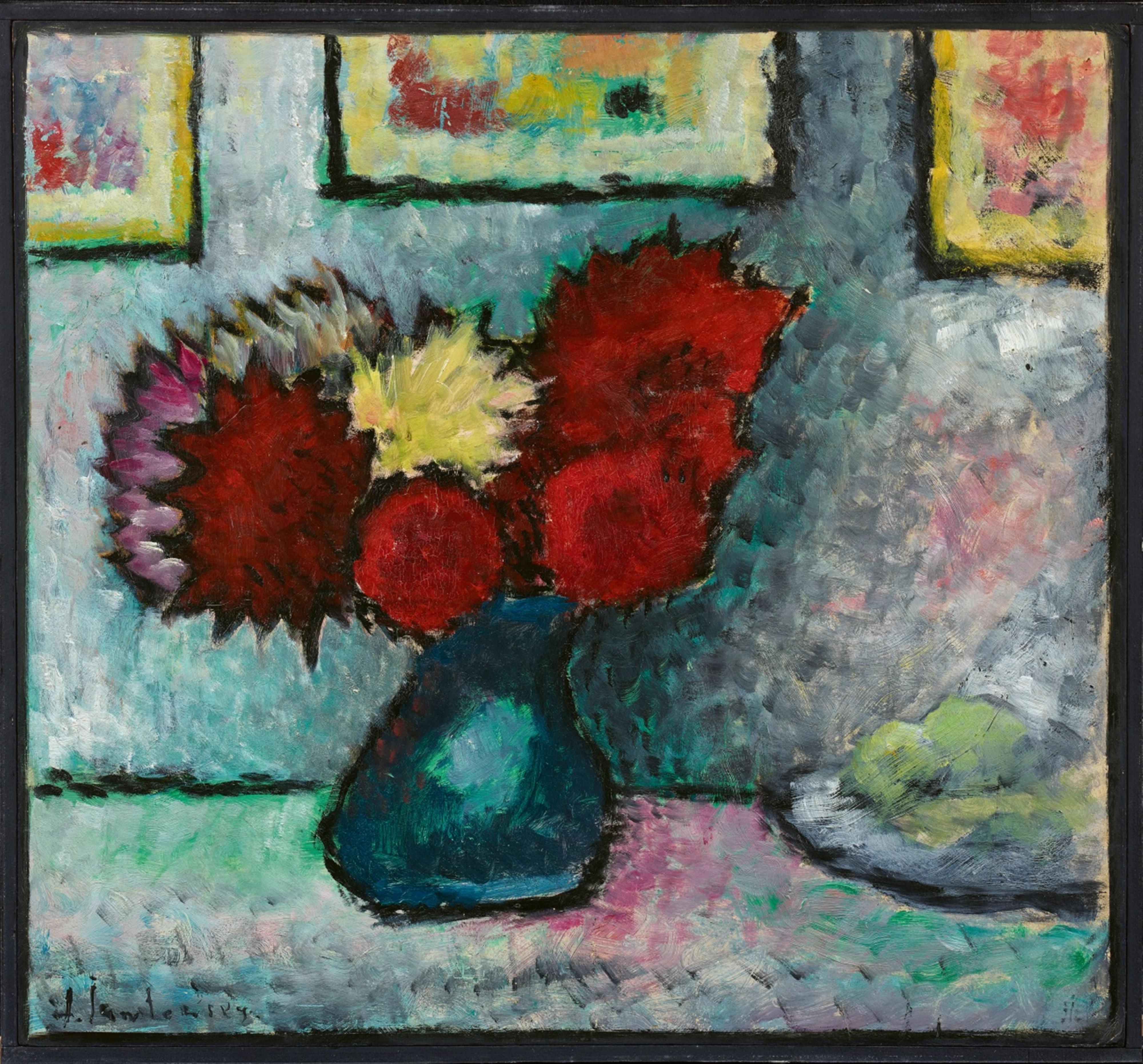Alexej von Jawlensky
Dahlien
1932
Oil on card, mounted on wooden panel 49 x 53.5 cm Framed. Signed 'A. Jawlensky.' in black lower left and dated '32' (barely readable) lower right. Verso with work details inscribed by Andreas Jawlensky. - Partially with fine craquelure, the corners partly slightly bumped.
Jawlensky's large still life from 1932, which was already listed by Clemens Weiler simply as “Dahlien”, may initially seem very surprising for viewers not completely familiar with the artist's oeuvre, on account of its composition and painterly approach: after all, everyone is aware of the dissimilar nature of the strictly geometric “Abstrakte Köpfe” from the preceding years and the stylistically no less radical “Meditationen” and small-format floral pieces of his late period. This period began in 1933 and is well known for the unique manner in which it sublimated Jawlensky's severe illness, which announced its presence in 1929 through paralytic symptoms. In the biographical as well as artistic rupture to be noted here, Jawlensky seems to have cautiously reassured himself - in the midst of the final phase of the series of “Abstrakte Köpfe” - by means of the rediscovered genre of the domestic still life.
Tayfun Belgien has spoken, with reference to Jawlensky's striking rigour in limiting himself to the still life, landscape and portrait, about the spiritually relevant “things” of his immediate “lifeworld”, which were “evidently” able to provide him with “the necessary inner support” (see Tayfun Belgin, Der Weg des Bildes. Über Kontinuität in der Kunst Alexej von Jawlenskys, in: exhib. cat., Alexej von Jawlensky, Reisen, Freunde, Wandlungen, Museum am Ostwall, Dortmund 1998, see p. 12). Within this context, which also includes this isolated example of his work, Jawlensky assured himself of his inner continuities and the abundance of his expressive power.
Jawlensky's dahlias are eruptive in their colour and form, and they are surrounded by a disparate, brighter chromatic space full of transparent, tonally neutralised shadows and reflections: a strong immanent contrast to the picture and it extends to the dark, heavy contours and the strict two-dimensional arrangement. The format of the picture also concludes in a forceful black outline. The interior structure is nonetheless vibrant and open because of the minute formulation of the brushstrokes, which literally covers the painting all over. In its feathery sort of motion and sensibility, it vaguely recalls the early years in which Jawlensky assimilated Post-Impressionist influences and the painting of van Gogh and Cézanne, Gauguin and Matisse studying the value of the utilised painterly techniques for his own work.
The quotation of the pictures decorating the wall suggests the surrounding interior and what was important to Jawlensky. A visitor recounted that, in his room in Wiesbaden, there were Persian miniatures and, in a “special arrangement, little pictures by Klee, Kandinsky, Nolde and himself” (see Clemens Weiler, Alexej von Jawlensky, Cologne 1959, p. 138).
Catalogue Raisonné
Maria Jawlensky/Lucia Pieroni-Jawlensky/Angelica Jawlensky II 1413 (there: "(am Atelierfenster)")
Certificate
We would like to thank Angelica Jawlensky Bianconi, Muralto, for kind additional advice.
Provenance
Estate of the artist; Galerie Grosshennig, Düsseldorf (1964), formerly Collection Richard König, Duisburg; in family possession, Rhineland, since
Literature
Clemens Weiler, Alexej von Jawlensky, Cologne 1959, cat. no. 756 with illus. p. 281
Exhibitions
Düsseldorf 1964/1965 (Galerie Grosshennig), Meisterwerke des 19. und 20. Jahrhunderts. Gemälde - Plastik - Aquarelle, p. 19 with illus.

